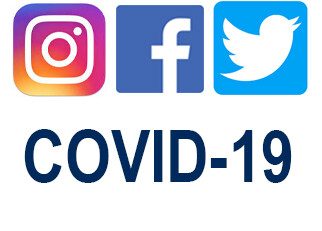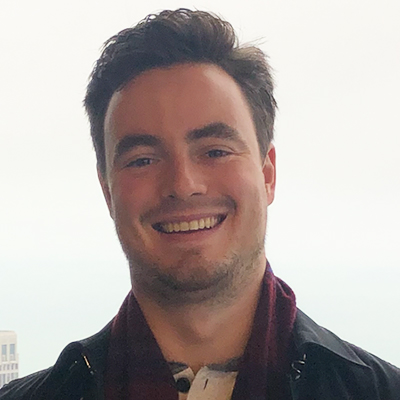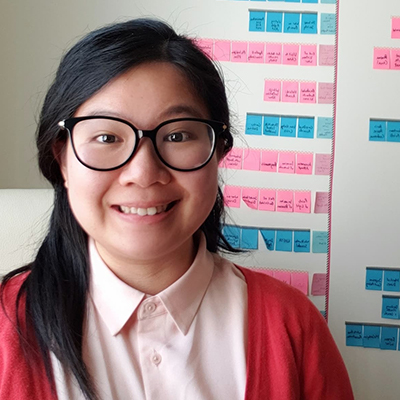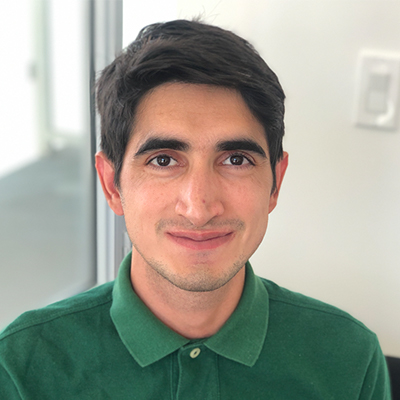Putting theory to the test: real world experience teaches students to mind the gap

“Knowledge translation can be very effective and very powerful if done in the right way and if you're targeting the right people,” says Evan Foster, a first-year student in the MHSc in Translational Research Program (known as the TRP) in the Department of Laboratory Medicine & Pathobiology. A lesson he and his team learned when they took a theory-based project the extra mile and put it into practice.
As a project-based program, the students were tasked with creating a proposal for their class: Knowledge Translation and the Community (facilitated by TRP faculty Dr. Christopher Klinger and Dr. Raza Mirza, and Course Director Dr. Gabriella Chan).
Concerned with rising cases among younger people in the second wave of the COVID-19 pandemic and the amount of misinformation circulating, the team, comprised of Evan Foster, Sally Moy and Mufazzal Mahmud, created a proposal for The Covid-19 Safety Influencers Program (C-SIP).
Inspired by viral social media messaging around COVID-19 public safety measures by experts such as Dr. Naheed Dosani at the Department of Family and Community Medicine, the team wanted to see if it was possible to empower young people to spread public safety messaging on social media.
 “We were very concerned that the public health messaging wasn’t getting across to young people,” explains Evan, “We felt there needed to be a more effective way to communicate to that age group.”
“We were very concerned that the public health messaging wasn’t getting across to young people,” explains Evan, “We felt there needed to be a more effective way to communicate to that age group.”
Not satisfied with producing the required proposal for their course, the team decided to put their knowledge into action and carry out the project beyond the proposal. Although not required, such enterprise is encouraged in the program. “We always tell our students that they get out of the program what they put into it,” explains TRP faculty member Dr. Richard Foty, “They learn from the formal teaching, from each other, and from their own experiences during the program, so we deliberately recruit people who are going to take these kinds of initiatives.”
Indeed, putting their theory into practice was where they learned the most. A key part of the TRP is teaching its students to communicate effectively with different audiences and to ‘unlearn’ their biases and assumptions: a lesson the team certainly learned when they interacted with their target group.
“First of all, we learned that working with high school students was harder than we thought as there are ethics and safety to consider, as well as tailoring to their needs”, says Mufazzal, ”the pupils also needed more guidance and support than we had anticipated.”
“We quickly realized that this age group can’t have the influence we had initially anticipated,” adds Sally, “they need parental permission, many can’t have public social media accounts, so their circle of influence, although important, is considerably smaller than we thought.”
The students had to adjust their assumptions about how high school students could become social media influencers. "We wanted the students to focus on the impact and the outcomes of their project, and not just about the number of people you could reach", says Dr. Mirza.
 Evan adds, “We also assumed that young people would automatically know what to do on social media and be confident in creating engaging content for it. Although they did a great job, they needed a lot of coaching and help as many are social media consumers, but not content creators.”
Evan adds, “We also assumed that young people would automatically know what to do on social media and be confident in creating engaging content for it. Although they did a great job, they needed a lot of coaching and help as many are social media consumers, but not content creators.”
Although the team learned that their own assumptions and biases about young people and social media meant this age group was not the most effective at meeting their primary social media goals of creating social media influencers, they discovered they were important voices in a different way. "High school students often rely on social media as their source for news, so can be exposed to a lot of misinformation. It is imperative that we develop strategies to equip this age group and audience with the right knowledge and information, and the C-SIP program is an example of this" said Dr. Mirza.
“One of our goals was to explore the idea of using students as knowledge brokers to disseminate information to their classmates and families,” says Mufazzal, “and to this end, the project was successful. We created great ambassadors, of not only COVID-19 public health information but also of scientific information, of fact-checking and I hope, provoked an interest in research.”
The team ran a series of webinars over several weeks which covered topics such as hand-washing, vaccines, and social issues related to the pandemic. “It was a lot of fun to learn how to engage with the students,” adds Evan, ”we had to make it informational but also very entertaining.”
“Through this program, we've definitely given them more confidence in their knowledge and understanding of COVID-19 that they can use within their circle of influence,” continues Evan. ”Our original plan was to make a difference to the community, and I’m sure we did, but the biggest impact was on the individual students: on their confidence and curiosity.”
 Digital volunteering opportunities are limited for high school students during the pandemic, so the team made C-SIP eligible for volunteer community involvement hours required to earn Ontario Secondary School Diplomas. The team is now seeking ways to continue the program to provide volunteer opportunities for high school students in the Greater Toronto Area, to keep them informed about the ongoing pandemic, and expand the program to more schools.
Digital volunteering opportunities are limited for high school students during the pandemic, so the team made C-SIP eligible for volunteer community involvement hours required to earn Ontario Secondary School Diplomas. The team is now seeking ways to continue the program to provide volunteer opportunities for high school students in the Greater Toronto Area, to keep them informed about the ongoing pandemic, and expand the program to more schools.
"The students should be commended for creating the C-SIP program in an innovative way that can be easily scaled and replicated to leverage the power of social media for other public health issues, or as part of disaster or emergency responses, ", says Mirza.
As well as learning valuable lessons about assumptions, bias, communication, and working in the community, the team also benefited from teaching. “We learned so much more about COVID-19: having to research a topic so you can teach it is a very powerful way to learn. The whole project was such a positive experience”, says Sally.
Find out more
The Translational Research Program (TRP) website
Why we teach to unlearn: the non-traditional path of translational research
Students on the TRP program lead the way in their own learning about health equity



